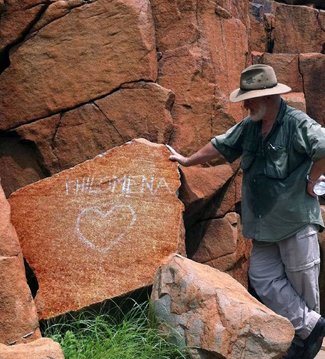Aboriginal rock art site vandalised

VANDALS ARE DEFACING ANCIENT rock engravings on the Burrup Peninsula, leaving stark reminders in graffiti that the National Heritage-listed area lacks effective protection.
Greens MP and rock art researcher Robin Chapple says he recently visited the site in northwest Western Australia, and discovered the word ‘Philomena’ scratched on the surface of a rock.
“Other visitors had been there a week before and not seen this damage, so it was done in the days before my visit,” says Robin. More cases of defaced rocks were spotted nearby in Climbing Man Valley, one of the most spectacular rock art galleries in the state.
The Burrup has the largest concentration of rock ‘carvings’ in the world, which include lively etched images of humans, birds, mammals, fish and abstract patterns that Aboriginal people are believed to have carved between 6,000-20,000 years ago. A gas processing plant, a port and other industry is also located on the peninsula.
Endangered heritage
Damaging rock art is an offence under the Aboriginal Heritage Act 1972 and penalties range from $20,000 to $40,000 and imprisonment for nine months to two years. The Department of Indigenous Affairs (DIA) says it takes reports of damage seriously and “will follow up on reported damage, including graffiti at the Burrup.”
Last year, a cement company agreed to pay $280,000 in remediation after it admitted it had damaged rock art during quarrying operations on the Burrup.
“A major problem is that due to the resource boom, we have a lot of people with no knowledge of the Aboriginal heritage value of the area or its international importance,” says Robin. “In human terms it is the equivalent of vandalising Stonehenge or the Pyramids.”
He says the precinct remains on the World Monument Fund’s list of 100 Most Endangered Places in the World – the only such site in Australia – because of continued mismanagement of the heritage and conservation values of the Burrup.
Local threats
The Centre for Rock Art Studies at the University of Western Australia has also sounded a warning that increased human traffic in remote parts of the Pilbara and Kimberley is a major threat to rock art. “Vandalism and dust from busy roads are now two of the biggest threats to rock art in the north of the state,” says Associate Professor Jane Balme.
She says the Burrup graffiti shows a deep disrespect for the traditional owners of the art and for world heritage. “One of the aims of our work in the Pilbara is to educate people who do not understand the value of this art to learn to appreciate its values. In my view, that often works better than just telling people what they can or cannot do.”
A DIA spokesman says a companies must produce a cultural heritage management plan as a condition of receiving approvals for major projects under the Aboriginal Heritage Act.
But Robin Chapple says rangers need to be installed on site and cultural programs stepped up. “People need to be made aware that they are desecrating a place of international importance.”
RELATED STORIES

